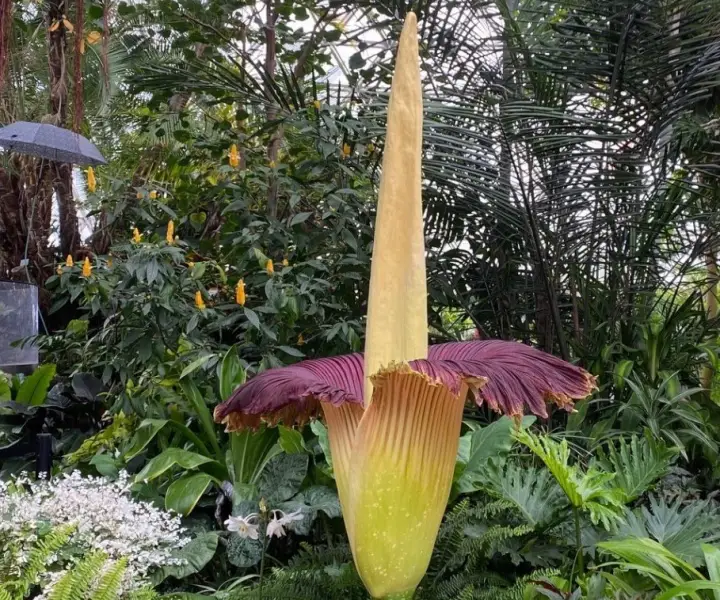Titan Arum (Amorphophallus titanum), also known as the “corpse flower,” is one of the rarest and most fascinating plants in the world. With its enormous size, striking appearance, and infamous scent, growing this plant is a challenge but a rewarding experience for enthusiasts.
This guide will cover everything you need to know about caring for and cultivating Titan Arum successfully.
Understanding Titan Arum
What is Titan Arum?

Titan Arum (Amorphophallus titanum) is a remarkable flowering plant native to the tropical rainforests of Sumatra, Indonesia. It is renowned for producing one of the largest and most dramatic inflorescences in the plant kingdom, often towering over 3 meters (10 feet) in height. Unlike many plants that bear a single large flower, Titan Arum features an inflorescence—a cluster of tiny flowers arranged on a central spike called the spadix, which is encased by a large, petal-like structure known as the spathe.
What makes Titan Arum particularly famous is the foul odor it releases during its blooming phase. This scent, resembling decomposing flesh, serves an important ecological function: attracting carrion beetles and flesh flies, which act as its primary pollinators. These insects, typically drawn to decaying organic matter, unknowingly facilitate cross-pollination as they move between plants.
Beyond its impressive size and unusual fragrance, Titan Arum is also notable for its rarity and unpredictable blooming cycle. It takes years, sometimes over a decade, for a single plant to bloom, making each flowering event a significant occasion for botanists and plant enthusiasts worldwide.
Lifecycle of Titan Arum
Titan Arum follows a complex and fascinating life cycle, which unfolds in several distinct stages, each crucial to the plant’s survival and reproduction.
The cycle begins in the underground phase, where the plant exists as a large, energy-storing tuber. During this dormancy period, which can last for months or even years, the tuber conserves resources until conditions are favorable for growth. When sufficient energy is accumulated, the plant transitions into its vegetative growth phase. At this stage, instead of producing a flower, Titan Arum develops a single, enormous leaf, which can resemble a small tree with a thick stem and a wide, umbrella-like canopy. This leaf plays a crucial role in photosynthesis, capturing sunlight to generate the nutrients necessary for future flowering. The leaf may persist for more than a year before withering away, after which the plant may enter another period of dormancy.
After several cycles of leaf growth and dormancy, Titan Arum eventually gathers enough stored energy to enter its most dramatic phase: flowering. The inflorescence begins as a tightly wrapped bud that slowly unfurls into its full, towering form over the course of several weeks. However, once fully bloomed, the spectacle is short-lived, lasting only 24 to 48 hours before the structure begins to collapse. During this brief window, the spadix heats up, intensifying the emission of its corpse-like scent to attract pollinators from great distances.
If successfully pollinated, the plant transitions to the seed production phase. The once-magnificent inflorescence gives way to clusters of red-orange berries, which take several months to mature. These berries contain the seeds necessary for propagation, ensuring the next generation of Titan Arum plants. In the wild, birds and other animals consume the berries and disperse the seeds across the rainforest, facilitating the continuation of this rare and extraordinary species.
Because of its prolonged and unpredictable growth cycle, along with the challenge of natural pollination, Titan Arum remains one of the most elusive and captivating plants in the world, drawing crowds whenever it blooms in botanical gardens worldwide.
How to Grow Titan Arum
Growing Titan Arum (Amorphophallus titanum) is a challenging but rewarding endeavor that requires careful attention to environmental conditions, soil composition, and proper care. As a tropical plant native to Sumatra, it thrives in warm, humid environments, making greenhouses or climate-controlled indoor settings ideal for cultivation outside its natural habitat.
Choosing the Right Environment
Titan Arum flourishes in conditions that closely mimic the rainforest ecosystem. It requires consistently warm temperatures, high humidity, and nutrient-rich soil to develop properly. Since it is not frost-tolerant, those living in temperate or cold climates should grow it in a greenhouse or a specially designed indoor space with regulated temperature and humidity levels. When growing Titan Arum outdoors, it should only be planted in tropical or subtropical regions where temperatures do not drop significantly.
Soil Requirements
The right soil mix is crucial for Titan Arum’s health and growth. The plant prefers soil that is well-draining yet rich in organic nutrients to support its extensive underground tuber system. The ideal soil conditions include:
- Good drainage: Prevents water from pooling around the tuber, which can cause rot.
- High organic content: Provides essential nutrients for robust growth.
- Slightly acidic to neutral pH (6.0-7.0): Ensures optimal nutrient absorption.
- Loamy or sandy texture: Allows for better aeration around the tuber.
A recommended soil mix consists of peat moss, compost, and perlite, which together provide moisture retention, organic nutrients, and aeration. Alternatively, a mixture of potting soil with sand and orchid bark can help improve drainage while still holding enough moisture for healthy growth.
Temperature and Humidity
To successfully cultivate Titan Arum, maintaining the right temperature and humidity levels is essential. The plant thrives in consistently warm conditions, with ideal temperatures ranging between 75-85°F (24-29°C). Sudden drops in temperature can slow its growth or even cause dormancy to extend.
Humidity plays a significant role in simulating the rainforest environment. Titan Arum requires at least 80% humidity to grow properly. If grown indoors, a humidifier can help maintain the necessary moisture levels in the air. Heat lamps or grow tents may also be used to ensure a stable tropical climate. If growing outdoors in a tropical setting, mulching around the base of the plant can help retain moisture.
Light Requirements
Titan Arum thrives in bright but indirect sunlight, similar to the dappled light found on the rainforest floor. Direct exposure to intense sunlight can scorch its leaves, leading to stress and slowed growth. The best lighting conditions include:
- Bright, filtered sunlight: Ideal for promoting healthy leaf development.
- Partial shade in outdoor settings: Helps prevent excessive heat stress.
- Artificial grow lights indoors: If natural sunlight is insufficient, full-spectrum LED grow lights can be used to supplement light exposure.
Positioning the plant near a bright window with sheer curtains can provide the right amount of indirect sunlight. If using grow lights, keep them at an appropriate distance to avoid overheating the plant.
Watering and Fertilization
Watering Titan Arum
Titan Arum requires consistent moisture, but overwatering can be detrimental. The key to proper watering is maintaining soil that is evenly moist but never soggy. Here are the best watering practices:
- Water deeply to ensure the moisture reaches the entire tuber.
- Allow excess water to drain freely to prevent root rot.
- Reduce watering during dormancy, as the tuber requires less moisture when not actively growing.
It is essential to monitor soil moisture regularly, as inconsistent watering can affect the plant’s ability to store energy for future growth. If the soil remains too wet for extended periods, the tuber may become susceptible to fungal infections.
Fertilization
Since Titan Arum has long periods of vegetative growth before flowering, proper fertilization is necessary to support its energy storage. During the active growth phase, the plant benefits from a balanced, all-purpose fertilizer such as 10-10-10 or 20-20-20.
- Apply fertilizer every 2-4 weeks during the growing season.
- Use a diluted liquid fertilizer to prevent nutrient overload.
- Reduce feeding once the plant enters dormancy to allow the tuber to rest.
Organic fertilizers like well-decomposed compost or fish emulsion can also be beneficial, providing slow-release nutrients that support tuber development. Over-fertilization should be avoided, as excessive nutrients can lead to weak growth rather than encouraging the plant to flower.
Propagation of Titan Arum
Propagating Titan Arum (Amorphophallus titanum) is a slow and meticulous process, requiring careful handling and specific environmental conditions. The plant can be propagated either from seeds or by dividing mature tubers. However, both methods demand patience, as the plant’s growth cycle is long, and it may take years before a new plant reaches maturity.
Growing from Seeds
Propagation from seeds is the most natural way to grow Titan Arum, but it requires fresh, viable seeds and a controlled environment. The process involves several key steps:
- Seed Selection and Preparation: Fresh seeds should be obtained from a reputable source or harvested from an existing Titan Arum plant if pollination was successful. The seeds are typically encased in bright red-orange berries, which should be carefully cleaned to remove the surrounding pulp, as it contains substances that may inhibit germination.
- Choosing the Right Growing Medium: The seeds should be planted in a well-draining medium that retains moisture without becoming soggy. A suitable mix consists of peat moss, perlite, and compost, ensuring aeration and nutrient availability. Some growers also use a blend of sand and coco coir to improve drainage while maintaining consistent moisture.
- Planting and Moisture Control: The seeds should be sown just below the soil surface, with a thin layer of soil covering them lightly. Maintaining high humidity and consistent moisture is crucial for germination. To achieve this:
- The soil should remain damp but not overly wet to prevent fungal growth.
- A humidity dome or plastic wrap can be placed over the container to create a greenhouse effect.
- Misting the surface regularly can help sustain the required moisture levels.
- Temperature and Germination Time: Titan Arum seeds require warm conditions to germinate. The optimal temperature range is 75-85°F (24-29°C). Under ideal conditions, germination can take anywhere from several weeks to several months, with some seeds sprouting faster than others. Once seedlings emerge, they should be gradually acclimated to their growing environment to prevent stress.
Propagation from Tubers
Titan Arum can also be propagated vegetatively by dividing large tubers during repotting. While less common than seed propagation, this method allows for quicker establishment of new plants, as the tubers already contain stored energy for growth.
- Selecting a Mature Tuber for Division: Tubers that have reached a sufficient size (usually weighing several kilograms) can be divided when the plant is dormant. Division is typically done when repotting, as the tuber is exposed and easier to handle at this stage.
- Making Proper Cuts: Using a sterilized knife, the tuber should be cut into sections, ensuring that each division has at least one growing point (or bud). These buds are necessary for the new plant to sprout.
- Drying and Preventing Infection: After cutting, the divided sections should be left to air dry for a few days before planting. This drying period allows the cut surfaces to heal and form a protective callus, reducing the risk of rot and fungal infections. Some growers apply powdered fungicide or cinnamon to the cut surfaces to further prevent decay.
- Replanting the Divided Tubers: Once dried, the tuber sections should be planted in a well-draining soil mix, similar to the one used for mature plants. The tubers should be positioned so that the growth point faces upward. After planting, the soil should be kept lightly moist but not excessively wet to avoid rotting.
Common Issues and How to Fix Them
Growing Titan Arum (Amorphophallus titanum) can be challenging, as it requires precise environmental conditions and long-term care. Various factors, including pests, diseases, and slow growth, can affect its development. Understanding these common issues and their solutions can help ensure a healthy and thriving plant.
Pests and Diseases
Like many tropical plants, Titan Arum is vulnerable to certain pests and diseases, particularly in greenhouse or indoor environments where airflow and humidity levels can fluctuate.
1. Root Rot
Cause: Overwatering and poor drainage can cause the tuber to rot, leading to soft, mushy roots and eventual plant death.
Solution:
- Use well-draining soil with a mix of perlite, sand, and organic matter to prevent excess moisture retention.
- Water the plant only when the top layer of soil feels dry.
- Ensure pots have drainage holes, and avoid letting water accumulate at the bottom of the container.
- If root rot occurs, remove the affected portions of the tuber, let it dry, and treat it with fungicide before replanting in fresh soil.
2. Fungal Infections
Cause: High humidity, stagnant air, or excessively wet conditions can lead to fungal diseases such as leaf spots and tuber rot.
Solution:
- Improve air circulation by using fans in enclosed spaces like greenhouses.
- Avoid overhead watering; instead, water at the base of the plant.
- Apply a fungicide if signs of fungal infection appear, such as brown or black spots on the leaves.
- Reduce humidity slightly if fungal issues persist, while still maintaining adequate moisture for plant health.
3. Pests: Aphids, Spider Mites, and Scale Insects
Cause: Greenhouse and indoor-grown plants are particularly susceptible to common plant pests, which feed on the leaves and stems, weakening the plant.
Solution:
- Inspect the plant regularly, especially under the leaves and along the stem.
- If pests are detected, spray with a mixture of water and insecticidal soap or neem oil.
- For severe infestations, use a mild insecticide or introduce natural predators like ladybugs to control aphids.
- Wipe scale insects off using a cotton swab dipped in rubbing alcohol.
Slow Growth or No Flowering
Titan Arum is notorious for its slow growth and unpredictable flowering cycle. However, certain factors can further delay its bloom or stunt its growth.
1. Improper Growing Conditions
Cause: Insufficient light, incorrect temperature, or poor soil nutrition can slow the plant’s growth.
Solution:
- Maintain temperatures between 75-85°F (24-29°C) to simulate its tropical habitat.
- Provide bright, indirect sunlight or supplement with grow lights.
- Use well-draining, nutrient-rich soil with compost and organic matter to support tuber growth.
2. Inadequate Fertilization
Cause: A lack of essential nutrients can prevent the plant from reaching maturity and storing enough energy to flower.
Solution:
- Apply a balanced fertilizer (10-10-10 or 20-20-20) every 2-4 weeks during the active growing season.
- Supplement with phosphorus-rich fertilizer occasionally to promote flowering.
- Reduce fertilization when the plant enters dormancy to allow it to rest.
3. Natural Growth Cycle Delays
Cause: Even under perfect conditions, Titan Arum has an extremely long maturation period before it flowers for the first time. The process can take anywhere from 7 to 10 years, or even longer.
Solution:
- Patience is key—Titan Arum follows its own growth schedule.
- Focus on tuber size—a larger, well-developed tuber increases the chances of blooming.
- Ensure consistent care throughout its growth cycle, as stress or neglect can prolong the time until flowering.
Conclusion
Growing Titan Arum requires dedication, but the reward is an extraordinary botanical experience. By providing the right conditions, regular care, and patience, you can successfully cultivate one of the most remarkable plants on Earth.






